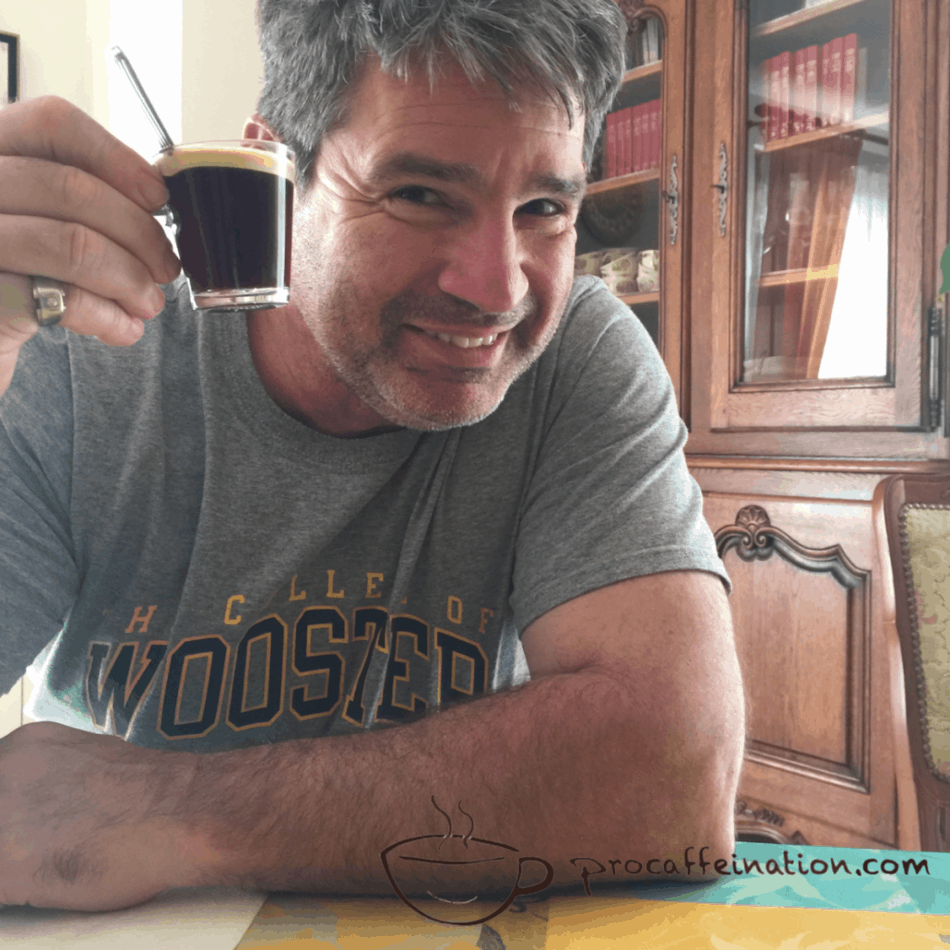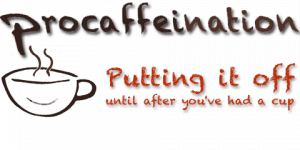Espresso is trendy in the United States and extremely common in European countries. But it’s not what you think it is; it’s not the drink in your cup, it’s the method used to prepare it!
Espresso is a method of brewing coffee in which hot water of 202ºF (94.4 C) is forced under 9 atmospheres of pressure through a compressed bed of finely ground coffee. It is the key ingredient in many coffee drinks using various combinations of heated, frothed, and foamed milk.
What that means is, should you find yourself in Italy, the birthplace of espresso, don’t ask for one! More correctly, and particularly in Italy, “espresso” is a technical term that has to do with the brewing process. Instead, just order “un caffè.”
Tim Bruno, Procaffeination: A Coffee Lover’s Dictionary
History of Espresso
Coffee and the Age of Steam
The path to the creation of the modern espresso begins in the 19th century. By this time, coffee was big business across Europe, with cafes dotting the landscape of cities, towns, and villages. The big drawback the coffeehouse proprietors faced was the amount of time it took to brew individual cups. Obviously, the more quickly a cup could be prepared, the greater the profits. As this was the “age of steam,” it is no surprise that someone would try to use boiling water to automate the process. Angelo Moriondo of Turin, Italy was granted a patent in 1884 for a bulk brewing mechanism used at the Turin General Exposition.
The First Espresso

In 1903, Luigi Bezzerra and Desiderio Pavoni worked together to commercialize Bezzerra’s improvements on Moriondo’s machine and by the 1906 Milan Fair presented “Cafèe Espresso” – Coffee on the Spur of the Moment. While their machines could produce up to 1000 cups of coffee per hour, steam, being 212ºF (100 C), is too hot for proper brewing. The resulting cups suffered from over-extraction and bitterness.
Modern Espresso
After World War II, Angelo Gaggia, developed a method utilizing a cylinder and hand-operated lever to force water of the proper temperature through the ground coffee. This had three benefits: it decreased the brewing temperature, improving quality, simultaneously increased the pressure from the 1.5 atmospheres of steam to the 9 atmospheres still used today, and it produced the golden crema we have come to expect in a properly pulled shot. It is also the origin of the term “pulling a shot!”
Further advances in technology made it possible to eliminate the “skilled barista” who could pull the lever at the proper pressure by using a spring mechanism to automate the application of pressure. Most modern espresso machines now use a pump to further guarantee this correct pressure.
Terms Used in Espresso
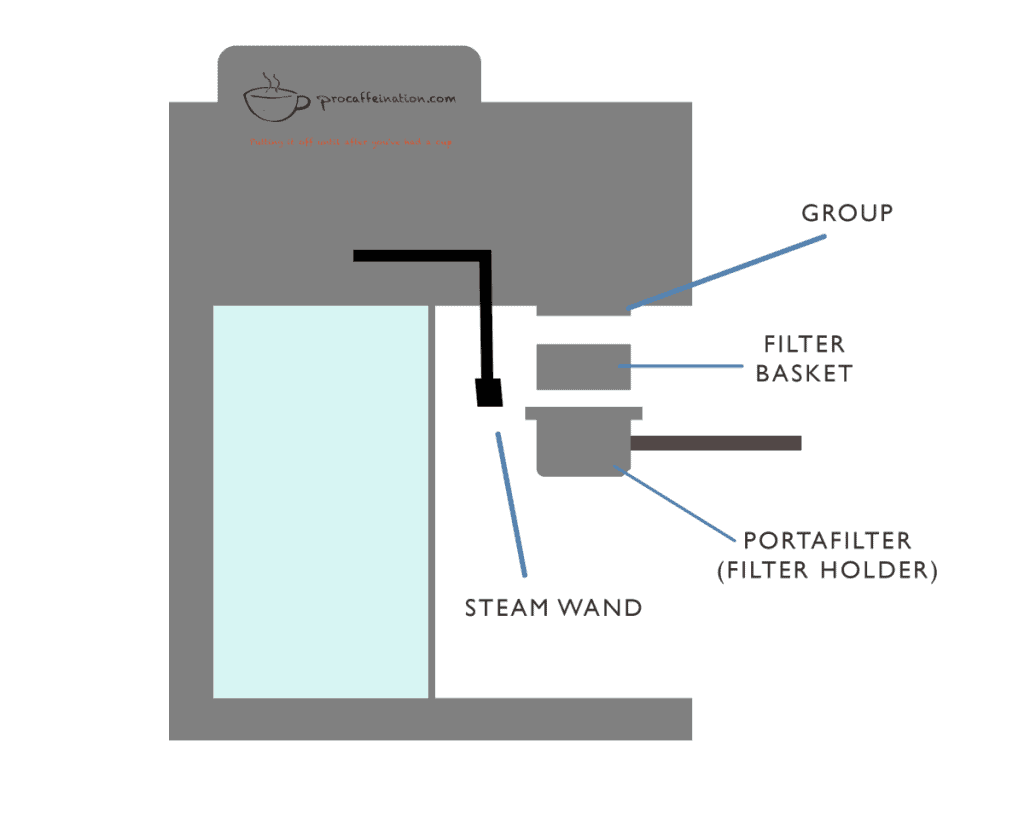
The group is the fixture protruding from the front of most espresso machines into which the portafilter and filter clamp. It is also known as the delivery group, the brew head, or a shower head.
The portafilter or filter holder is the metal device with a plastic or wooden handle that holds the coffee filter basket and clamps onto the group.
The steam wand is the small protruding pipe on most espresso machines that is used to froth and texture milk. It is also known as the nozzle, the pipe, or a stylus.
The water is heated in espresso machines by a system called the thermal block. Generally, they use coils of pipe enclosed inside a heating element or water tank.
A tamper is a small, circular device with a flat end that is used to compress the ground coffee in the filter basket of the espresso machine. This is done to ensure there are no air pockets in the coffee that would affect the flow of water.
The compacted ground coffee removed from the portafilter after pulling an espresso shot is called a puck.
The knockbox is a bin or box with a rubber or wooden bar that you whack the portafilter against in order to remove the spent puck after an espresso shot has been pulled.
Similar Brews to Espresso
There are a few ways to brew coffee that are designed to mimic the espresso experience. They are not EXACTLY espresso but can give you a hot, black, caffeinated beverage that is almost but not entirely unlike espresso.
Moka Pot
The Moka pot was invented in Italy by Alfonso Bialetti in 1933. This successfully brought espresso out of the coffee bar and into everyone’s home. Also known as a caffetierra, from the Italian for “coffee maker,” the Moka pot is a stovetop or electric pot that uses pressurized steam to force hot water and steam through finely-ground coffee. Variations on the basic design allow for coffee more similar to coffee bar espresso and cappuccino to be brewed. Bialetti is the most famous brand.
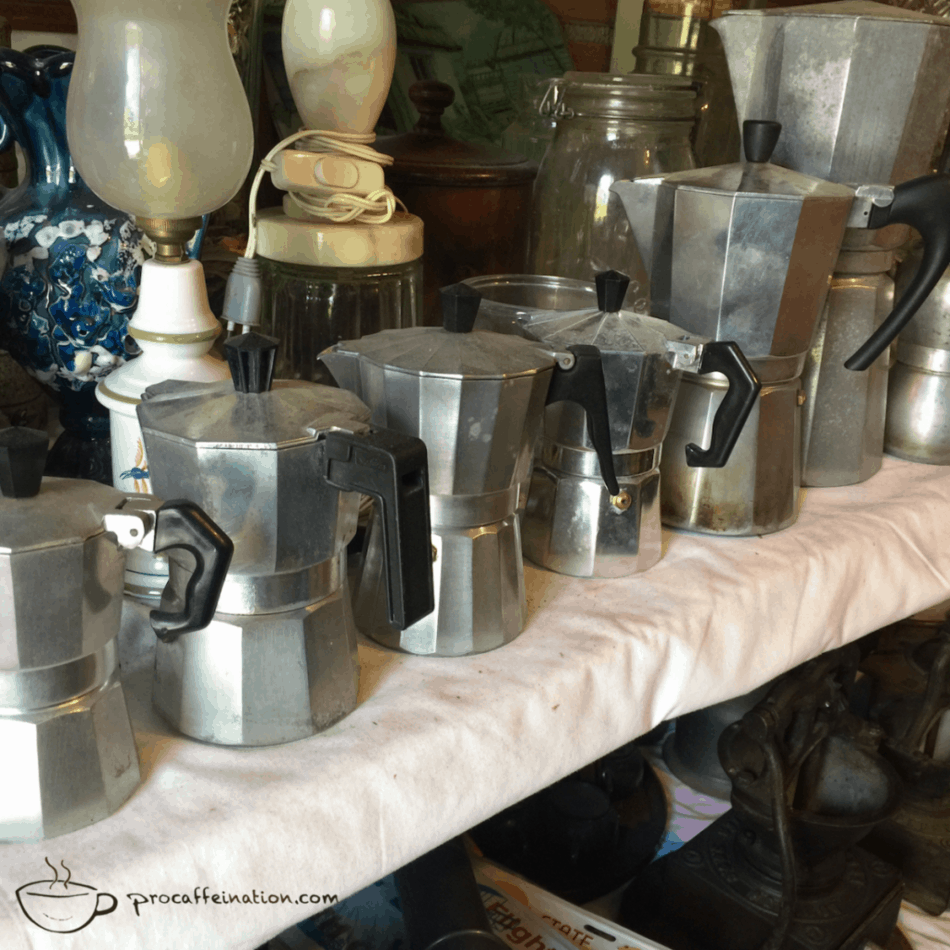
Since it is ostensibly using similar brewing temperature and pressure as pre-Gaggia espresso and was well-adopted before the Gaggia invention, I think it is a legitimate inclusion here.
Procaffeination Moka Pot Brewing Tip: For the best flavor, less bitterness caused by too hot water during the brewing, and a quicker finish to the whole process, pre-heat your water to boiling before putting it in the pot. Then close up the pot and use a medium-high heat to finish the brewing.
Aeropress
Aeropress is not bad and it brews a decent cup of joe but it is not espresso. But it is in the ballpark! You do use hand pressure to push the hot brewing water through the ground coffee. Unfortunately, it is nearly impossible to generate enough pressure to create crema, which is necessary for a proper espresso.
French Press
Nah. You can make a strong cup of coffee and use the plunger to try to force water through the grounds but that’s not what a French press is designed to do.
Is a Nespresso espresso?
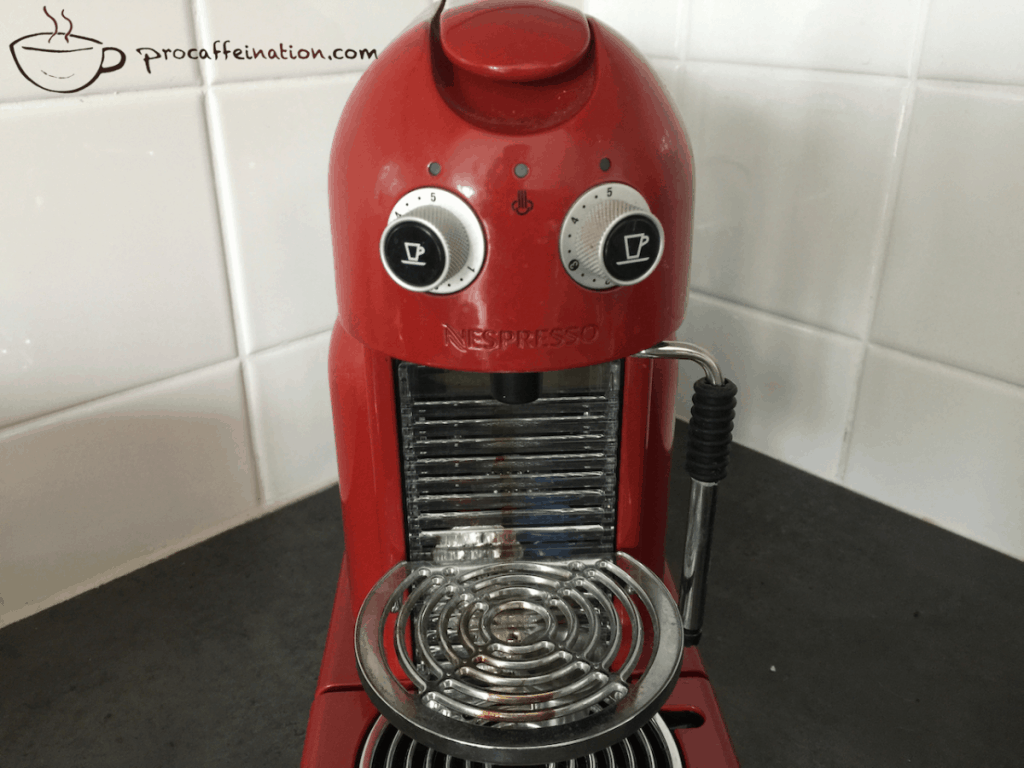
Nespresso® is the operating unit of the Nestlé Group that markets machines and capsules – not pods – to conveniently brew single servings of espresso and coffee; mine is a fancy Krupps model with a steam wand (it has been discontinued but here is another fancy one on Amazon). A basic Nespresso doesn’t allow you to refine your process, so if you are looking for the perfect cup, this probably isn’t it. BUT – it is consistently good, an excellent option, and pretty darn close to true espresso.
Is Senseo espresso?
Senseo says it themselves: “The Senseo® coffee machine… is not like an espresso machine. It is a Coffee Pod System that makes a sensational cup of freshly brewed coffee with a rich crema layer on top.” It’s fine. You can definitely drink it.
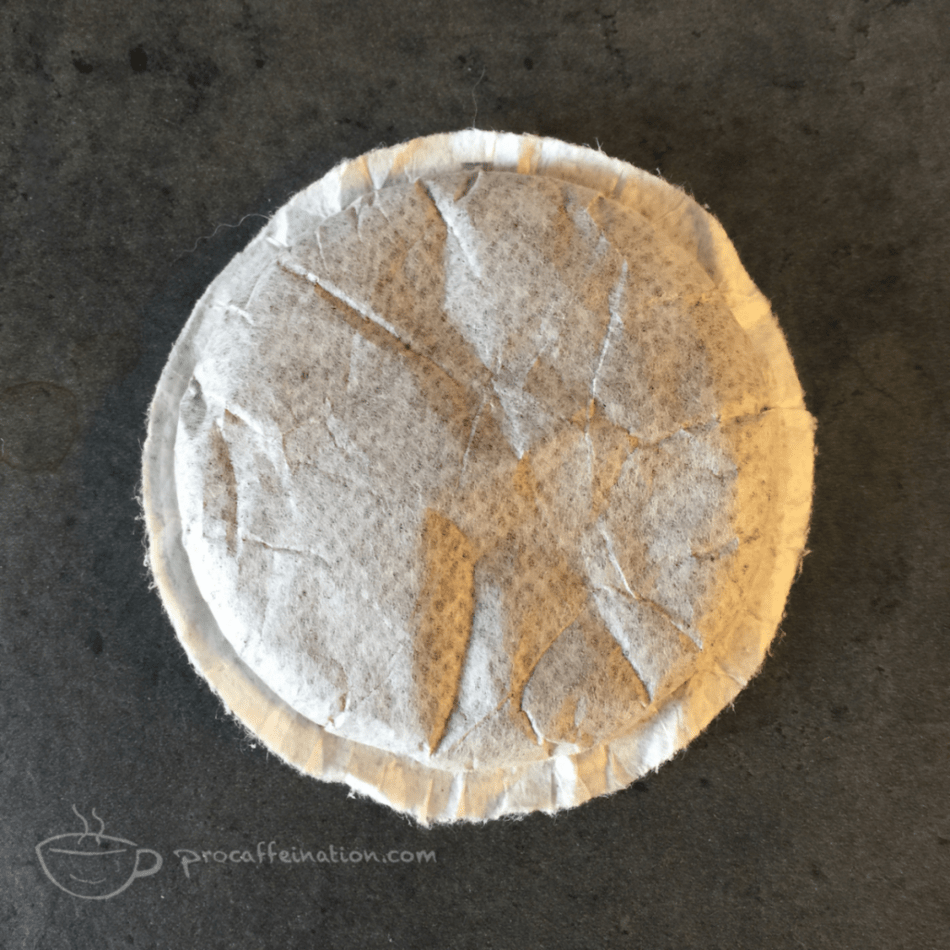
Back in 2017, Tom Hanks made a media splash by sending a high-end espresso machine to the White House press corps in order to give them a caffeinated boost in their continued “fight for truth.” The unit he purchased has been discontinued but this one is almost the same.
Frequently Asked Questions About Espresso
Is espresso stronger than coffee?
Yes. And by a lot! A shot of espresso uses a water to coffee ratio of around 2:1 : about twice as much water than coffee by volume. This is far higher than the 18:1 ratio in brewed coffee. That makes espresso nine times stronger than brewed coffee.
But! Since an espresso shot only has about 75mg of caffeine, it will give you less of a jolt than a 10 oz mug of coffee, which comes in at around 200mg.
What is the difference between espresso and regular coffee?
You may have heard the term espresso roast. It is a vague term for coffee that has been roasted anywhere between French roast and Spanish roast. Right in the middle of these two levels is Italian roast, an “official” roasting level that is much darker than the traditional American roast and, in fact, may even be burnt. It is usually thin-bodied, and bittersweet in flavor, with an overlay of burned and charcoal-like tones. Often, Arabica beans will be blended 50/50 with Robusta beans to give extra body to the espresso.
Coffee does not have to be dark roasted to make an excellent espresso. Ideally, you want a coffee that will make a rich crema. Dark is just the norm because Italians generally like their coffee roasted dark and as we learned earlier, they invented espresso.
What coffee drinks are made with espresso?
There’s more to espresso than “just a shot.” Since everyone’s taste varies, plenty of coffee drinks have developed where a shot is an ingredient!
Americano is an espresso lengthened with hot water to make a full cup giving you something to sip while having a conversation
doppio is a double shot of espresso
lungo is the Italian word for “long” and if you order one you will get a double shot made with more finely ground coffee and twice the water of a regular espresso; lighter but stronger than a regular espresso
café crema is the old name for espresso but now means a coffee similar to a lungo pulled with double water
ristretto comes from the Italian word for restricted and if you order it, you will get a short shot of espresso made with more finely ground coffee and half the water but with the same amount of time as a regular espresso, making for a denser but not as strong beverage
bullseye or hammerhead is a cup of brewed coffee with a shot of espresso in it
black eye is a cup of brewed coffee with an added double shot of espresso
dead eye is a cup of brewed coffee with three shots of espresso
Gibraltar is a double-shot of espresso with a bit of milk, served in a small Libbey “Gibraltar” tumbler; the milk cools the coffee so it can be slammed and your barista can get back to work
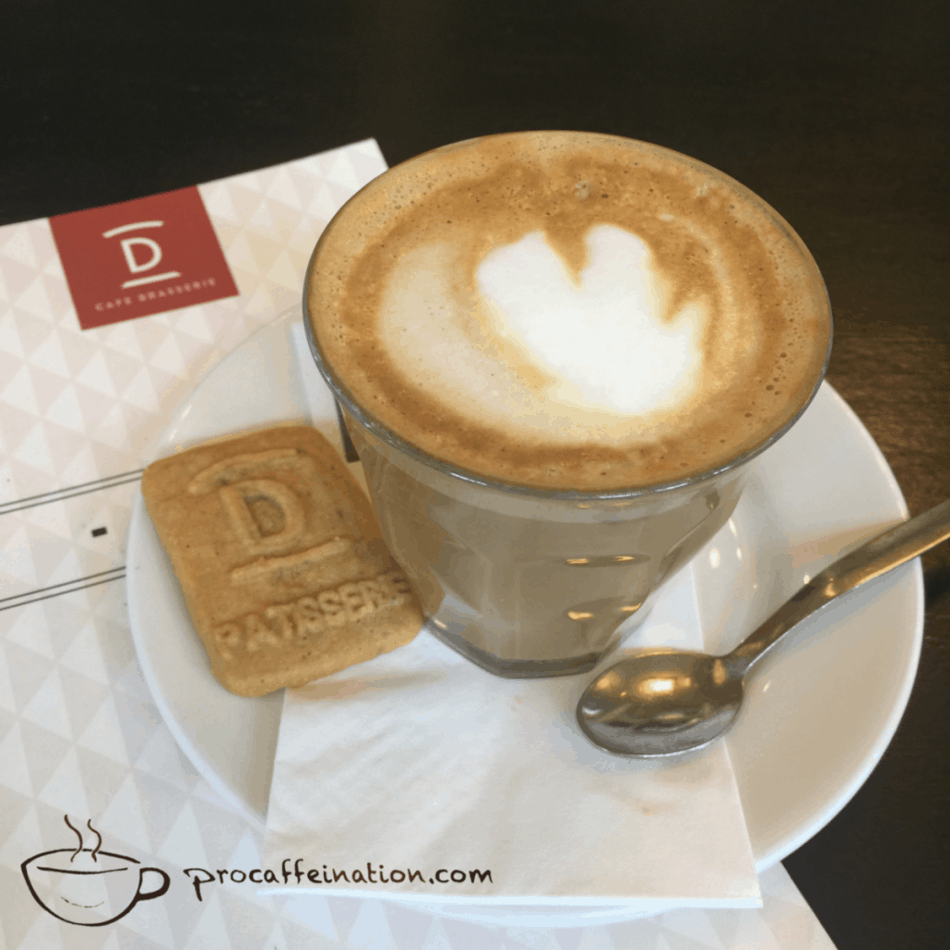
cappuccino is a coffee drink made of equal parts by volume of espresso, steamed milk, and milk foam
cappuccino chiaro is a cappuccino prepared with more milk than usual; also known as a wet or light cappuccino
cappuccino freddo is a cappuccino served over ice
cappuccino scuro is a cappuccino with half the frothy milk and double the foam; also known as a dry or dark cappuccino
marocchino is a fashionable coffee drink from Milan, Italy that is sort of an upside-down cappuccino served in a small glass: first a sprinkle of cocoa powder, then frothed milk, then a shot of espresso
cortado is a shot of espresso with an equal amount of steamed – but not textured – milk
latte means milk in Italian so you have to be more specific if you want to get the correct coffee drink
caffè latte means “coffee with milk” and what you should get is a beverage with a 2:1 ratio of milk to coffee. Outside of Italy, the barista will often give you a latte macchiato but your mileage may vary.
latte macchiato comes from the Italian for “milk marked” or more properly, “milk stained,” meaning milk that has been stained with coffee; the same ingredients and proportions as a caffè latte, but milk first, then the espresso, topped by foam; if you are looking for a mostly coffee drink, see caffè macchiato
caffè macchiato from the Italian for “coffee marked” or if you prefer, “coffee stained;” a shot of espresso with a dollop of milk foam; NOTE: If you were thinking of a milkier drink, see latte macchiato
For comparisons, check out Cappuccino, Latte, Macchiato: What’s the Difference?
flat white is similar to a cappuccino but with frothy milk instead of foam which sits under the crema
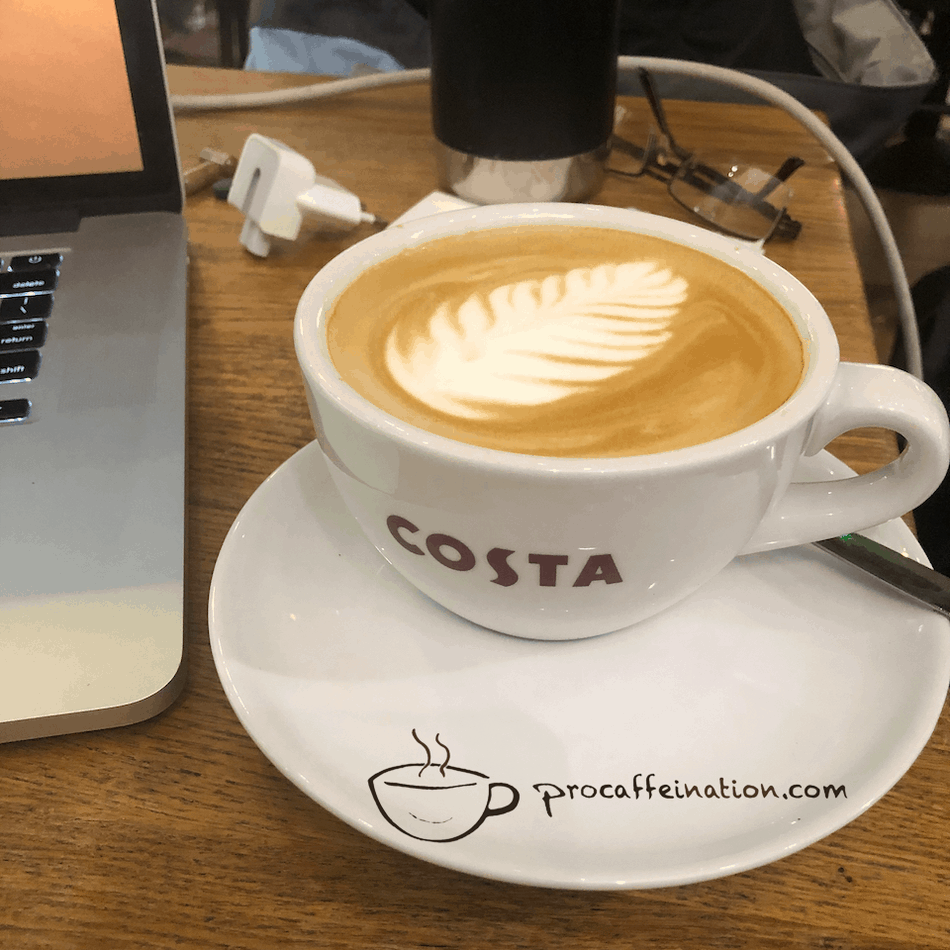
con panna is espresso with a dollop of whipped cream
café mocha is a shot of espresso plus a shot of hot chocolate or chocolate topping, topped with frothy milk and milk foam or whipped cream
Vienna coffee is equal parts espresso, frothy milk, and whipped cream
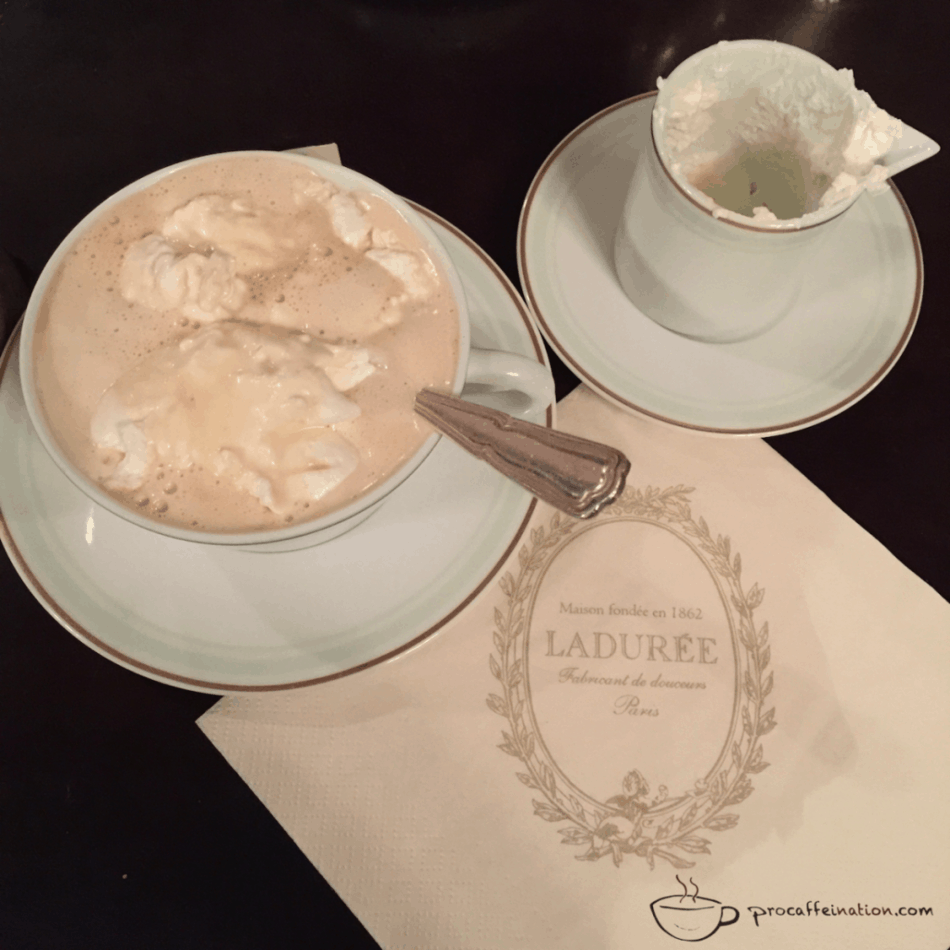
Fancy Drinks Made with Espresso
bicerin is a decadent drink from Turin, Italy consisting of layers of espresso, exquisite chocolate, and heavy cream
shakerato is made with espresso, simple syrup, and lots of ice, shaken vigorously until froth forms when poured and served in a martini glass; sometimes with Bailey’s Irish Cream
Mazagran is a cold coffee drink said to be created by soldiers of the French Foreign Legion in Algeria; the plain-Jane version is coffee, an ice cube, and seltzer water; Portuguese versions use lemon, sugar syrup, and maybe rum; in Austria, you will get an espresso with an ice cube and rum and down it in one gulp; in Catalonia, it is simply iced coffee and lemon
Espresso Martini
When a British top model walked into a London bar in 1984 and asked for a drink that could wake her up and $*&^$%# her up, the famous Espresso Martini was born. Sophisticated, edgy, and unexpectedly strong.
1 espresso cup of Kahlúa
1 espresso cup of vodka
1 espresso cup of espresso
simple syrup to taste
Shake the Kahlúa, vodka, and espresso together with plenty of ice. Do this for 10 seconds for optimal frothiness. Strain into a cocktail glass. Float a coffee bean or two on top for a little class.
Ca phe trung is a Vietnamese coffee specialty: an espresso topped with a meringue-like fluff made of whipped sweetened condensed milk and egg yolk
Desserts made with Espresso
Dutch coffee is a spectacular concoction consisting of a cup of steamed milk, a melted-in pat of butter, and a shot of espresso in a tall glass mug. Then stir in two tablespoons of chocolate syrup and 1/8 teaspoon of vanilla extract. Pile on lots of whipped cream and top with a cinnamon stick. Do not count calories.
affogato is the Italian word for “drowned” and refers to a scoop of vanilla gelato topped with a hot espresso. Here’s one I had during a trip to London.
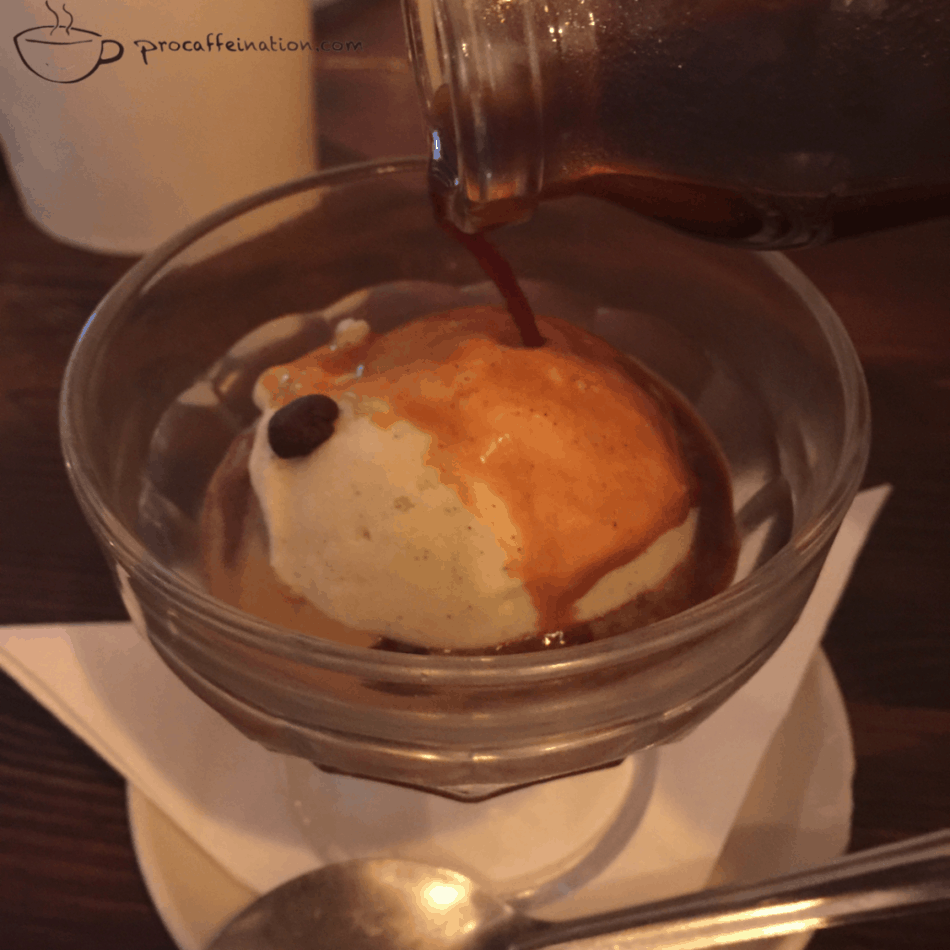
Tiramisu is from the Italian for “a pick me up,” and is a worthy dessert choice when there is no cheesecake. It consists of layers of espresso and liqueur-soaked ladyfingers, a mascarpone cheese cream mixture, and topped with powdered chocolate.
So now you know
You now know that espresso is not really a drink, it’s a method of preparing coffee. You also know that there are a myriad of possibilities in how to drink one and that it also has great use as an ingredient in other coffee drinks and desserts.
Let’s face it, espresso is a pretty terrific thing. If you have the proper setup, you can have a quick, flavorful caffeine boost in a relatively short time. With its smaller volume, it’s the perfect accompaniment to either an afternoon break or as the first step of an afternoon nappuccino.
